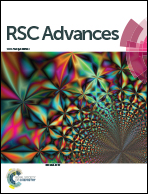Mussel-inspired ultrathin film on oxidized Ti–6Al–4V surface for enhanced BMSC activities and antibacterial capability
Abstract
To improve the biocompatibility and antibacterial capability of thermally oxidized Ti–6Al–4V, an ultrathin alginate/chitosan film that contains nano-silver was constructed through mussel-inspired poly(dopamine). The hybrid structure was successfully fabricated on the Ti–6Al–4V surface without deterioration of the rough surface induced by thermal oxidation (TO). The hybrid surface was characterized by the use of contact angle goniometry (CAG), atomic force microscopy (AFM), scanning electron microscopy (SEM), X-ray photoelectron spectrometry (XPS), and energy dispersive spectrometry (EDS). Bone marrow stem cell (BMSC) viability, morphology and proliferation tests showed a significant increase due to the biomimetic chitosan/alginate film on Ti–6Al–4V. Furthermore, nano-silver particles incorporated into the chitosan/alginate film inhibited the growth of Escherichia coli (E. coil) and Staphylococcus aureus (S. aureus) without jeopardizing the improved BMSC viability, morphology and proliferation. More importantly, the expression of alkaline phosphatase (ALP) was significantly up-regulated after BMSCs were cultured on the Ti–6Al–4V-based hybrid structure. Overall, this study presents a promising strategy to improve biocompatibility and antibacterial capability of thermally oxidized Ti–6Al–4V alloy.


 Please wait while we load your content...
Please wait while we load your content...